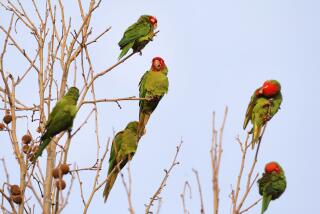In Portugal, white storks ‘addicted’ to junk food don’t bother to migrate
- Share via
The white stork is famous for its long-distance migration — at least it used to be. These days, more and more of the birds in Spain and Portugal choose to hang out by landfills year-round in search of a cheap meal.
In the past, during the warm months between March and September, the birds would nest and breed on the Iberian Peninsula; then in the winter, they would head to sub-Saharan Africa (Mali, Senegal and Kenya), where there’d be plenty of food.
But at some point in the 1980s, the storks changed their minds.
The climate in the birds’ northern home was getting milder, and there were plenty of frogs, beetles, worms and the invasive American crawfish for them to forage on year-round. Perhaps the biggest bonus was a never-ending food supply in the form of landfills.
Eventually, the storks in Portugal just gave up on the whole migration thing.
“They don’t bother to migrate [anymore],” said Aldina Franco, a conservation ecologist at the University of East Anglia in Norwich, England.
Storks from all over Europe (that used to migrate to the sub-Sahara, too) have flocked to Portugal in the last 20 years to the point where the population has grown from about 1,000 in 1995 to 14,000 in 2014.
In a recent study published in the journal Movement Ecology, Nathalie Gilbert, a doctoral student, and her supervisor, Franco, wanted to investigate how the landfills have reshaped the birds’ migratory behavior.
To find out if the birds had truly become “addicted” to junk food, the researchers monitored 48 white storks with special tracking tags that periodically relayed bursts of data through a cellular phone network. The tags, temporarily mounted to the animals, contained a GPS device and an accelerometer, similar to those found in cellphones, that recorded the bird’s speed and its motions on X, Y, and Z axes.
The accelerometer data allowed researchers to determine what the stork was doing at the time of each data transmission. For example, the researchers could clearly tell when the birds were looking down, a sign they were tending their eggs in the nest. The scientists verified GPS data by matching it with in-field observations.
The data from the GPS trackers, along with some field observations, confirmed the scientists’ suspicion: The storks were occupying their nests all year.
“White storks rely on landfill sites for foraging, especially during the nonbreeding season when other food resources are scarcer,” the authors wrote. “This artificial food supplementation probably facilitated the establishment of resident populations.”
There are advantages for those that stay, Franco said.
Once the storks decide the weather is right for breeding, their nests are already prepared for eggs and hatchlings. Birds returning from migration, by contrast, must first find and ready a nest. This means the sedentary storks can breed earlier — and the chicks that hatch earlier tend to fare better, possibly due to better food availability.
The storks, which would typically migrate thousands of miles south for winter, now fly just under 30 miles to grab a bite at the landfill instead.
Just how far a stork was willing to travel depended on the season and the distance from nest to landfill. For example, the birds tended to stay closer to the nest during the breeding season, traveling on average about 19 miles.
Also, the closer the stork nested to the trash heap, the more likely it was to use it. If the stork nested farther away, it was more likely to forage for its natural food items. During the breeding season, white storks generally ate more healthful fare because prey is easier to find in the warm months.
So are the storks really addicted to junk food? The short answer is yes, but that doesn’t mean they’ve gotten lazy, Franco said. They’re just opportunistic.
“It’s what we’d expect,” she said. “They try to find the resources closest to the nest, and as long as they find the resources to sustain themselves then they won’t travel as far.”
However, the storks’ garbage buffet may come to an end soon, and when it does it will provide researchers with a rare opportunity to observe further changes in migratory behavior.
New European Union regulations aim to limit the amount of biodegradable food waste entering landfills this year, and open-air landfills are being converted to covered facilities that birds can’t get into.
In the immediate future, the researchers predict dramatic consequences for the stork population that has come to depend on the landfills. But after that, the researchers want to see if the storks will manage to kick their junk food addiction.
“We’re really curious to see whether individual birds will have the capacity to change their migratory behavior,” Franco said. “Will they die because they don’t have enough food? Will they start to migrate again, or will they move somewhere else to find food?”
Follow me on Twitter @seangreene89 and “like” Los Angeles Times Science & Health on Facebook.
ALSO
Yosemite’s granite cliffs are ‘breathing,’ and heat can make them fall
This ‘Kite Runner’ arthopod kept its young tethered to its body with strings
Fungus that has killed roughly 7 million bats has now reached the West Coast







